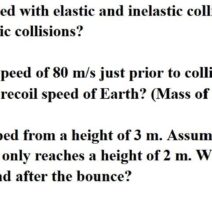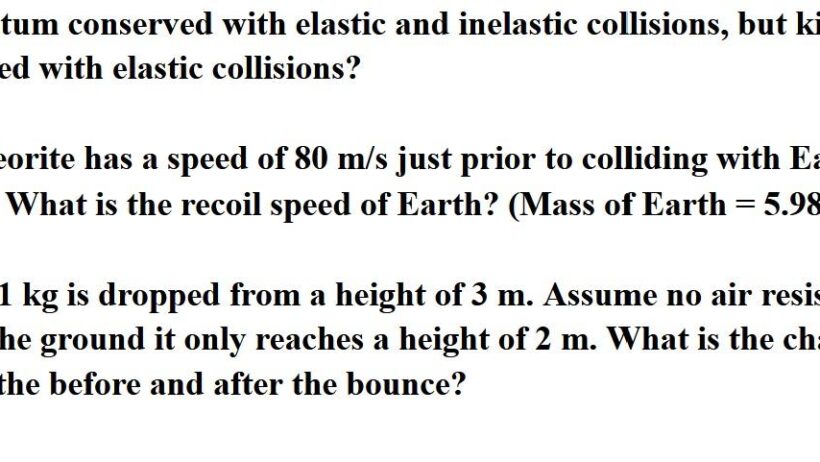Understanding the conservation of energy during collisions is a fundamental concept in physics, particularly when discussing elastic and inelastic collisions. This topic not only elucidates the dynamics of moving bodies but also touches upon principles that govern energy transfer in various physical systems. Grasping these concepts contributes to a more comprehensive perspective on energy conservation as a whole.
Collisions can broadly be categorized into two types: elastic and inelastic. An elastic collision is one in which both momentum and kinetic energy are conserved. This principle arises from interactions where individuals involved do not experience any lasting deformation, and kinetic energy is exchanged but not transformed or lost. The classic examples of elastic collisions occur at the microscopic level—such as collisions between gas molecules. However, at a macroscopic scale, perfectly elastic collisions are rare, as they tend to occur under idealized conditions.
On the contrary, inelastic collisions are characterized by the transformation of kinetic energy, where momentum is conserved, but kinetic energy is not. During an inelastic collision, some of the kinetic energy is transformed into other forms of energy, such as thermal energy or sound. An everyday example of inelastic collisions can be observed when cars crash; they crumple upon impact, indicating that a significant amount of kinetic energy is converted into internal energy of deformation.
To comprehend these principles thoroughly, it is essential to analyze the fundamental equations governing both types of collisions. In elastic collisions, the equations maintain that both momentum (p) and kinetic energy (KE) are conserved. Mathematically, this is represented as:
- Momentum Conservation: m1v1i + m2v2i = m1v1f + m2v2f
- Kinetic Energy Conservation: 1/2 m1v1i2 + 1/2 m2v2i2 = 1/2 m1v1f2 + 1/2 m2v2f2
Inelastic collisions, however, can be encapsulated with a similar momentum conservation equation, devoid of kinetic energy preservation:
- Momentum Conservation: m1v1i + m2v2i = m1v1f + m2v2f
- Kinetic Energy Loss: Kinetic energy before collision > Kinetic energy after collision
It’s pertinent to note that during an inelastic collision, the percentage of energy transformed into heat or sound is dependent on several factors, including the materials involved and the relative velocities of the colliding bodies. As an example, rubber balls tend to demonstrate a near-elastic behavior, while clay hitting a hard surface exhibits an inelastic nature; most of the energy translates into internal energy, deforming the clay.
Furthermore, the notion of perfectly elastic or perfectly inelastic collisions serves as a simplification for teaching purposes and does not often occur in reality. Perfectly inelastic collisions occur when two objects become so deformed during a collision that they stick together after the impact. Here, maximum energy transformation takes place. In this case, the equations adjust to reflect the united masses:
- Momentum Conservation: (m1 + m2)vf = m1v1i + m2v2i
The comprehensive understanding of these fundamental types of collision underlines their significance in practical applications, ranging from vehicle safety design to particle physics studies. The principles of momentum and energy conservation are integral to the development of collision avoidance technologies, artificial intelligence, and even sports science, where optimizing performance involves understanding the dynamics of elastic and inelastic impacts.
Moreover, collisions in nature often display a combination of elastic and inelastic characteristics. For instance, the interaction between ocean waves and a shoreline involves energy transformation and momentum exchange. Similarly, celestial collisions, such as those occurring between asteroids or during the formation of planets, can exhibit either behavior based on the speed and mass of the celestial bodies involved.
In conclusion, while elastic collisions allow for the conservation of both momentum and kinetic energy, inelastic collisions emphasize that energy transformation is a natural phenomenon and crucial for understanding interrelations within physical systems. Understanding these concepts provides deeper insights into energy conservation as a broader principle—one that defines countless interactions found within our universe. The study of these collisions not only deepens our comprehension of mechanical dynamics but also enhances our awareness of sustainable energy practices and conservation efforts in an environmentally conscious society.




